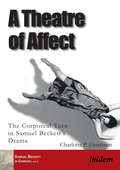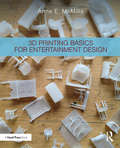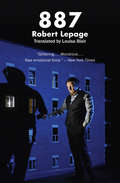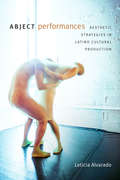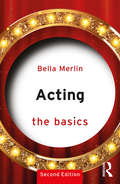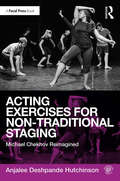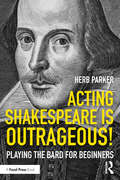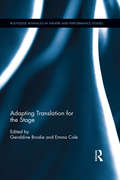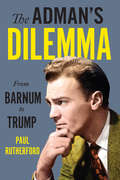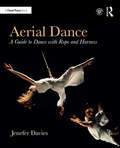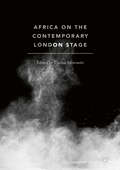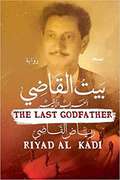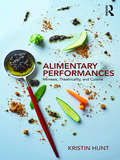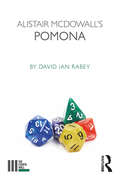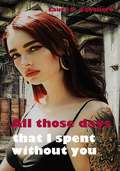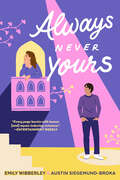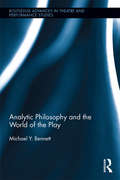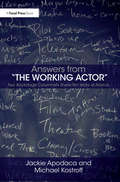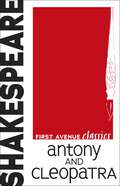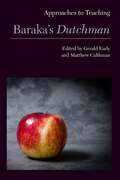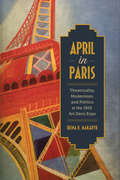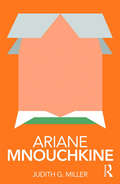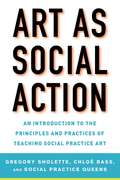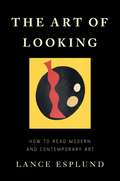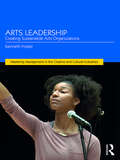- Table View
- List View
A Theatre of Affect: The Corporeal Turn in Samuel Beckett's Drama (Samuel Beckett in Company #3)
by Charlotta P. EinarssonCombining phenomenological analysis with dance and performance analysis and affect theory, A Theatre of Affect: The Corporeal Turn in Samuel Beckett's Drama takes stock of the various ways in which the body in Samuel Beckett's drama participates in the affective ecology of performance. Affect is here located in the materiality of the body and discussed in relation to the symbolic significance of, for instance, the effort, direction, speed, or duration of a posture, movement, or gesture. Although the meaning of the body in Beckett's stage-images cannot be mapped onto conventional discursive meanings, the significance of the body's formal modulations is affective in the sense that the import of such changes is immediately recognized and felt as significant by spectators. Beckett's theater of affect therefore is predicated on the infinitesimal stirrings of subliminal meaning-making that continuously shape and create the world in experience.
3D Printing Basics for Entertainment Design
by Anne E. McMillsAffordable 3D printers are rapidly becoming everyday additions to the desktops and worktables of entertainment design practitioners – whether working in theatre, theme parks, television and film, museum design, window displays, animatronics, or… you name it! We are beginning to ask important questions about these emerging practices: · How can we use 3D fabrication to make the design and production process more efficient? · How can it be used to create useful and creative items? · Can it save us from digging endlessly through thrift store shelves or from yet another late-night build? · And when budgets are tight, will it save us money? This quick start guide will help you navigate the alphabet soup that is 3D printing and begin to answer these questions for yourself. It outlines the basics of the technology, and its many uses in entertainment design. With straightforward and easy-to-follow information, you will learn ways to acquire printable 3D models, basic methods of creating your own, and tips along the way to produce successful prints. Over 70 professionals contributed images, guidance, and never-before-seen case studies filled with insider secrets to this book, including tutorials by designer and pioneer, Owen M. Collins.
887
by Robert LepageFrom internationally acclaimed playwright and author Robert Lepage comes 887 — an autobiographical story originally toured as a solo show. Framed by Lepage’s attempt to memorize Michèle Lalonde’s poem “Speak White,” 887 is an exploration of memory, culture, and community in Quebec.As the 40th anniversary of La Nuit de la poésie in Montreal approaches, playwright Robert Lepage is invited to recite Michèle Lalonde’s seminal poem “Speak White” from memory on the special night. After agonizing hours spent attempting to memorize the piece, Lepage finds himself unable to recall a single line. In a last effort he decides to employ a mnemonic device dating back to ancient Greece called the Memory Palace — a technique of imagination and association. Lepage’s Memory Palace is 887 Murray Avenue, the apartment block where he grew up. Winding his way around the rooms of the building and the lives of the tenants therein, Lepage guides the reader through a world of recollections of 1960s Quebec, the decade that shaped the province’s cultural and political consciousness.A mesmerizing and multifaceted glimpse into the realm of memory, 887 is a tour of culture and community in 1960s Quebec through one masterful artist’s remarkable, boundary-defying perspective.
Abject Performances: Aesthetic Strategies in Latino Cultural Production (Dissident Acts)
by Leticia AlvaradoIn Abject Performances Leticia Alvarado draws out the irreverent, disruptive aesthetic strategies used by Latino artists and cultural producers who shun standards of respectability that are typically used to conjure concrete minority identities. In place of works imbued with pride, redemption, or celebration, artists such as Ana Mendieta, Nao Bustamante, and the Chicano art collective known as Asco employ negative affects—shame, disgust, and unbelonging—to capture experiences that lie at the edge of the mainstream, inspirational Latino-centered social justice struggles. Drawing from a diverse expressive archive that ranges from performance art to performative testimonies of personal faith-based subjection, Alvarado illuminates modes of community formation and social critique defined by a refusal of identitarian coherence that nonetheless coalesce into Latino affiliation and possibility.
Acting: The Basics (The Basics)
by Bella MerlinNow in a vibrantly revised second editon, Acting: The Basics remains a practical and theoretical guide to the world of the professional actor, which skilfully combines ideas from a range of practitioners and linking the academy to the industry. Retaining a balance between acting history, a discussion of pioneers and a consideration of the practicalities of acting techniques, the new edition includes a discussion of acting for the screen as well as the practicalities of stage acting, including training, auditioning and rehearsing. With a glossary of terms and useful website suggestions, this is the ideal introduction for anyone wanting to learn more about the practice and history of acting.
Acting Exercises for Non-Traditional Staging: Michael Chekhov Reimagined
by Anjalee Deshpande HutchinsonActing Exercises for Non-Traditional Staging: Michael Chekhov Reimagined offers a new set of exercises for coaching actors when working on productions that are non-traditionally staged in arenas, thrusts, or alleys. All of the exercises are adapted from Michael Chekhov's acting technique, but are reimagined in new and creative ways that offer innovative twists for the practitioner familiar with Chekhov, and easy accessibility for the practitioner new to Chekhov. Exploring the methodology through a modern day lens, these exercises are energizing additions to the classroom and essential tools for more a vibrant rehearsal and performance.
Acting Shakespeare is Outrageous!: Playing the Bard for Beginners
by Herb ParkerPerforming the work of William Shakespeare can be daunting to new actors. Author Herb Parker posits that his work is played easier if actors think of the plays as happening out of outrageous situations, and remember just how non-realistic and presentational Shakespeare's plays were meant to be performed. The plays are driven by language and the spoken word, and the themes and plots are absolutely out of the ordinary and fantastic - the very definition of outrageous. With exercises, improvisations, and coaching points, Acting Shakespeare is Outrageous! helps actors use the words Shakespeare wrote as a tool to perform him, and to create exciting and moving performances.
Adapting Translation for the Stage (Routledge Advances in Theatre & Performance Studies)
by Geraldine Brodie Emma ColeTranslating for performance is a difficult – and hotly contested – activity. Adapting Translation for the Stage presents a sustained dialogue between scholars, actors, directors, writers, and those working across these boundaries, exploring common themes and issues encountered when writing, staging, and researching translated works. It is organised into four parts, each reflecting on a theatrical genre where translation is regularly practised: The Role of Translation in Rewriting Naturalist Theatre Adapting Classical Drama at the Turn of the Twenty-First Century Translocating Political Activism in Contemporary Theatre Modernist Narratives of Translation in Performance A range of case studies from the National Theatre’s Medea to The Gate Theatre’s Dances of Death and Emily Mann’s The House of Bernarda Alba shed new light on the creative processes inherent in translating for the theatre, destabilising the literal/performable binary to suggest that adaptation and translation can – and do – coexist on stage. Chronicling the many possible intersections between translation theory and practice, Adapting Translation for the Stage offers a unique exploration of the processes of translating, adapting, and relocating work for the theatre.
The Adman’s Dilemma: From Barnum to Trump
by Paul RutherfordThe Adman’s Dilemma is a cultural biography that explores the rise and fall of the advertising man as a figure who became effectively a licensed deceiver in the process of governing the lives of American consumers. Apparently this personage was caught up in a contradiction, both compelled to deceive yet supposed to tell the truth. It was this moral condition and its consequences that made the adman so interesting to critics, novelists, and eventually filmmakers. The biography tracks his saga from its origins in the exaggerated doings of P.T. Barnum, the emergence of a new profession in the 1920s, the heyday of the adman’s influence during the post-WW2 era, the later rebranding of the adman as artist, until the apparent demise of the figure, symbolized by the triumph of that consummate huckster, Donald Trump. In The Adman’s Dilemma, author Paul Rutherford explores how people inside and outside the advertising industry have understood the conflict between artifice and authenticity. The book employs a range of fictional and nonfictional sources, including memoirs, novels, movies, TV shows, websites, and museum exhibits to suggest how the adman embodied some of the strange realities of modernity.
Aerial Dance: A Guide to Dance with Rope and Harness
by Jenefer DaviesAerial Dance: A Guide to Dance with Rope and Harness provides an introduction for the beginning aerialist. It covers rigging, equipment, advice on optimal conditioning, and a step-by-step guide to technique, including anatomical references, space and time considerations, and elements of force when working with and against gravity. Specific movements and choreography are framed anatomically and together reflect the pattern and order of an aerial technique class. Challenges inherent to this type of dancing are discussed, as well as wellness instruction and methods of altering these techniques for intermediate and advanced dancing. A companion website hosts video that corresponds with the technique and phrasing in the book.
Africa on the Contemporary London Stage
by Tiziana MorosettiThis collection of essays investigates the way Africa has been portrayed on the London stage from the 1950s to the present. It focuses on whether — and, if so, to what extent — the Africa that emerges from the London scene is subject to stereotype, and/or in which ways the reception of audiences and critics have contributed to an understanding of the continent and its arts. The collection, divided into two parts, brings together well-established academics and emerging scholars, as well as playwrights, directors and performers currently active in London. With a focus on Wole Soyinka, Athol Fugard, Bola Agbaje, Biyi Bandele, and Dipo Agboluaje, amongst others, the volume examines the work of key companies such as Tiata Fahodzi and Talawa, as well as newer companies Two Gents, Iroko Theatre and Spora Stories. Interviews with Rotimi Babatunde, Ade Solanke and Dipo Agboluaje on the contemporary London scene are also included.
Al-Kady House "The Last God-Father
by Riyad Al Kadihttps://www.amazon.co.uk/Riyad-Al-Kadi/e/B00J9J8HBW Great Book, to read it describes the world of the iraqi Mafia and the World of Weapon Trade. you will never be happy in this World full of betrayal and hatred even from the close beloved ones to you, you never be safe it decribes the changes happened upon the Iraqi Society after the Coup aganist the King,
Alimentary Performances: Mimesis, Theatricality, and Cuisine
by Kristin HuntA pea soda. An apple balloon. A cotton candy picnic. A magical mole. These are just a handful of examples of mimetic cuisine, a diverse set of culinary practices in which chefs and artists treat food as a means of representation. As theatricalised fine dining and the use of food in theatrical situations both grow in popularity, Alimentary Performances traces the origins and implications of food as a mimetic medium, used to imitate, represent, and assume a role in both theatrical and broader performance situations. Kristin Hunt's rich and wide-ranging account of food's growing representational stakes asks: What culinary approaches to mimesis can tell us about enduring philosophical debates around knowledge and authenticity How the dramaturgy of food within theatres connects with the developing role of theatrical cuisine in restaurant settings Ways in which these turns toward culinary mimeticism engender new histories, advance new epistemologies, and enable new modes of multisensory spectatorship and participation. This is an essential study for anyone interested in the intersections between food, theatre, and performance, from fine dining to fan culture and celebrity chefs to the drama of the cookbook.
Alistair McDowall's Pomona (The Fourth Wall)
by David Ian Rabey‘It’s all real. All of it. Everything bad is real’ - Moe Alistair McDowall’s Pomona was first staged in 2014 and won properly startling, and startled, acclaim. Its edgeland setting permits a surrealistic disengagement of linear forms of time, which is both dreamlike and wildly funny; nightmarish and ominously enveloping. The play has as its imaginative springboard a landscape which is both real and surreal. It offers an unforgettable journey into radical uncertainty, alongside unpredictable action that presents and questions the forms by which all too much of British life is lived. Rabey offers us a wild plunge into this modern English urban rabbit hole, a haunting and bewildering high-stakes hunt for meaning and value, set in a gothic noir Manchester, possibly dystopian (or possibly not).
All those days that I spent without you
by Laura Pérez CaballeroThis is the story of the relationship between two sisters who have never had anything in common and who have not seen each other for many years. A chance encounter brings them back together and through different characters we see that the coincidences are not left in that encounter, taking the story to a point of no return in which the ending becomes an unexpected drama. A novel that mixes feelings with a police plot written in a simple way that pushes to read one chapter after another in search of the end of the story.
Always Never Yours
by Emily Wibberley Austin Siegemund-Broka“An utterly charming story of love, family, heartbreak, and drama. I absolutely loved it!”—Morgan Matson, New York Times bestselling author of Since You’ve Been GoneMegan Harper is the girl before. All her exes find their one true love right after dating her. It's not a curse or anything, it's just the way things are. and Megan refuses to waste time feeling sorry for herself. Instead, she focuses on pursuing her next fling, directing theater, and fulfilling her dream school's acting requirement in the smallest role possible. But her plans quickly crumble when she's cast as none other than Juliet--yes, that Juliet--in her high school's production. It's a nightmare. No--a disaster. Megan's not an actress and she's certainly not a Juliet. Then she meets Owen Okita, an aspiring playwright who agrees to help Megan catch the eye of a sexy stagehand in exchange for help writing his new script. Between rehearsals and contending with her divided family, Megan begins to notice Owen--thoughtful, unconventional, and utterly unlike her exes, and wonders: shouldn't a girl get to play the lead in her own love story?
Analytic Philosophy and the World of the Play (Routledge Advances in Theatre & Performance Studies)
by Michael Y. BennettTheatrical characters’ dual existence on stage and in text presents a unique, challenging case for the analytical philosopher. Analytic Philosophy and the World of the Play re-examines the ontological status of theatre and its fictional objects through the "possible worlds" thesis, arguing that theatre is not a mirror of our world, but a re-creation of it. Taking a fresh look at theatre’s key elements, including the hotly contested relationships between character and actor; onstage and offstage "worlds"; and the play-text and performance, Michael Y. Bennett presents a radical new way of understanding the world of the play.
Answers from The Working Actor: Two Backstage Columnists Share Ten Years of Advice
by Jackie Apodaca Michael KostroffFor nearly a decade, Jackie Apodaca and Michael Kostroff shared duties as advice columnists for the actors’ trade paper, Backstage. Their highly popular weekly feature, "The Working Actor," fielded questions from actors all over the country. A cross between "Dear Abby" and The Hollywood Reporter, their column was a fact-based, humorous, compassionate take on the questions actors most wanted answered. Using some of their most interesting, entertaining, and informative columns as launch points, Answers from "The Working Actor" guides readers through the ins and outs (and ups and downs) of the acting industry. Apodaca and Kostroff share an approach that is decidedly "on the ground." They’ve both labored in the trenches just like their readers—dealing with auditions, classes, photos, résumés, rehearsals, contract negotiations, representatives, jobs, challenging colleagues, and the search for that elusive life/career balance. There are few absolutes in the acting profession and virtually no proven and reliable steps. Unlike books that claim to offer "Quick Steps to a Successful Acting Career," Answers from "The Working Actor" deals honestly with the realities, providing facts, options, strategies, stories, points of view, and the wisdom of experience, while ultimately challenging readers to make their own decisions. This book will give new actors a head start on their journeys and remind experienced professionals that, in the acting business, there is never only one answer to any question.
Antony and Cleopatra (First Avenue Classics ™)
by William ShakespeareTwo years after the assassination of Julius Caesar in 44 BC, three men—Octavius Caesar, Lepidus, and Mark Antony—rule the Roman Republic. Antony should be in Rome, helping to stop Pompey's rebel army, but he rarely leaves the side of his lover, Egypt's beautiful Queen Cleopatra. With war against Pompey imminent and tensions deepening between Rome's rulers, Antony agrees to marry Caesar's sister as a show of political loyalty. But Caesar has grander plans: he defeats Pompey, imprisons Lepidus, and then turns his sights on Antony. Can Cleopatra and Antony hope to stand against Caesar's powerful navy? A tale of ill-fated romance and warring empires, this is an unabridged version of one of English playwright William Shakespeare's last great tragedies, first performed in 1607 and published in Shakespeare's First Folio in 1623.
Approaches to Teaching Baraka's Dutchman (Approaches to Teaching World Literature #153)
by Matthew CalihmanFirst performed in 1964, Amiri Baraka's play about a charged encounter between a black man and a white woman still has the power to shock. The play, steeped in the racial issues of its time, continues to speak to racial violence and inequality today.This volume offers strategies for guiding students through this short but challenging text. Part 1, "Materials," provides resources for biographical information, critical and literary backgrounds, and the play's early production history. The essays of part 2, "Approaches," address viewing and staging Dutchman theatrically in class. They help instructors ground the play artistically in the black arts movement, the beat generation, the theater of the absurd, pop music, and the blues. Background on civil rights, black power movements, the history of slavery, and Jim Crow laws helps contextualize the play politically and historically.
April in Paris: Theatricality, Modernism, and Politics at the 1925 Art Deco Expo
by Irena MakarykAttracting over fifteen million visitors, the 1925 Paris Expo had an ambitious goal to create a new modernist style which would reflect the great scientific, industrial, and technological advances that produced a new spirit known as "modern." In April in Paris, author Irena R. Makaryk explores the theatre arts’ vital cultural and political impact at this celebrated international exhibition. Drawing extensively from unexplored archival documents from France, Austria, and North America, April in Paris is the first major study to focus on theatre arts at the 1925 Paris Expo and the audacious Soviet contributions to this fair. Turning a spotlight on the uses and representations of theatricalized spaces, Makaryk analyses their political challenge at a time when relations between the West and the USSR were rife with tension. Copiously illustrated with beautiful colour and black and white illustrations, this book elucidates the complex role of the international fair as a catalyst for spirited cultural debate and for aesthetic change.
Ariane Mnouchkine (Routledge Performance Practitioners)
by Judith MillerOver the last forty years, French director Ariane Mnouchkine and her theater collective, Le Théâtre du Soleil, have devised a form of research and creation that is both engaged with contemporary history and committed to reinvigorating theater by focusing on the actor. Now revised and reissued, this volume combines: ● an overview of Mnouchkine’s life, work and theatrical influences ● an exploration of her key ideas on theater and the creative process ● analysis of key productions, including her early and groundbreaking environmental political piece, 1789, and the later Asian-inspired play penned by Hélène Cixous, Drums on the Dam. ● practical exercises, including tips on mask work. As a first step toward critical understanding, and as an initial exploration before going on to further, primary research, Routledge Performance Practitioners offer unbeatable value for today’s student.
Art as Social Action: An Introduction to the Principles and Practices of Teaching Social Practice Art
by Gregory Sholette Chloë Bass Social Practice Queens"Art as Social Action . . . is an essential guide to deepening social art practices and teaching them to students." —Laura Raicovich, president and executive director, Queens MuseumArt as Social Action is both a general introduction to and an illustrated, practical textbook for the field of social practice, an art medium that has been gaining popularity in the public sphere. With content arranged thematically around such topics as direct action, alternative organizing, urban imaginaries, anti-bias work, and collective learning, among others, Art as Social Action is a comprehensive manual for teachers about how to teach art as social practice. Along with a series of introductions by leading social practice artists in the field, valuable lesson plans offer examples of pedagogical projects for instructors at both college and high school levels with contributions written by prominent social practice artists, teachers, and thinkers, including: Mary Jane Jacob Maureen Connor Brian Rosa Pablo Helguera Jen de los Reyes Jeanne van Heeswick Jaishri Abichandani Loraine Leeson Ala Plastica Daniel Tucker Fiona Whelan Bo Zheng Dipti Desai Noah Fischer Lesson plans also reflect the ongoing pedagogical and art action work of Social Practice Queens (SPQ), a unique partnership between Queens College CUNY and the Queens Museum.
The Art of Looking: How to Read Modern and Contemporary Art
by Lance EsplundA veteran art critic helps us make sense of modern and contemporary artThe landscape of contemporary art has changed dramatically during the last hundred years: from Malevich's 1915 painting of a single black square and Duchamp's 1917 signed porcelain urinal to Jackson Pollock's midcentury "drip" paintings; Chris Burden's "Shoot" (1971), in which the artist was voluntarily shot in the arm with a rifle; Urs Fischer's "You" (2007), a giant hole dug in the floor of a New York gallery; and the conceptual and performance art of today's Ai Weiwei and Marina Abramovic. The shifts have left the art-viewing public (understandably) perplexed.In The Art of Looking, renowned art critic Lance Esplund demonstrates that works of modern and contemporary art are not as indecipherable as they might seem. With patience, insight, and wit, Esplund guides us through the last century of art and empowers us to approach and appreciate it with new eyes. Eager to democratize genres that can feel inaccessible, Esplund encourages viewers to trust their own taste, guts, and common sense. The Art of Looking will open the eyes of viewers who think that recent art is obtuse, nonsensical, and irrelevant, as well as the eyes of those who believe that the art of the past has nothing to say to our present.
Arts Leadership: Creating Sustainable Arts Organizations (Mastering Management in the Creative and Cultural Industries)
by Kenneth FosterThe contemporary world faces unprecedented upheaval and change forcing institutions of all types to rethink how they are designed and how they must now function if they are to survive into an uncertain future. The performing arts are no exception; in an era of constant change and technological transformation, arts organizations and their leaders face significant organizational challenges if they are to maintain their relevance. Arts Leadership: Creating Sustainable Arts Organizations provides a contemporary overview of the field of arts leadership, focused on the performing arts. It examines what these challenges are, how they are affecting the performing arts and arts organizations in general and proposes creative ways to reimagine, build and lead sustainable arts organizations in this uncharted environment. With a global perspective drawn from his extensive experience advising arts organizations around the world and based on his own work successfully leading important performing arts organizations in the United States, Foster proposes an innovative approach to organizational design, systems, and structures for arts leaders in the 21st century that is based in ecological thinking and the creative process that is intrinsic to the arts. In disrupting conventional arts leadership practice, the book provides an exceptional tool to understand a unique sector, and is essential reading for students and practitioners across the creative and cultural industries.
